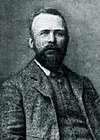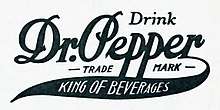Charles T. Pepper
| Charles T Pepper | |
|---|---|
 Dr. Pepper | |
| Born |
December 2, 1830 Big Spring, Virginia |
| Died |
May 28, 1903 (aged 72) Rural Retreat, Virginia |
| Nationality | American |
| Occupation | medical doctor |
| Known for | possibly inspiring name of soft drink |
Charles Taylor Pepper (December 2, 1830 – May 28, 1903), a 19th-century American medical doctor, is often cited as the inspiration for the name of the Dr Pepper brand soft drink, although this is uncertain.
Early life
Pepper was born in Big Spring, Virginia, on December 2, 1830.[1][2] His parents were John Pepper and Mary Robertson Pepper and he was their 12th child.[3] Pepper attended the University of Virginia for medical training and received a degree in 1855.[4][5]
Mid-life
Pepper married Isabella Howe (1838–1903) of Rural Retreat on May 18, 1858, in Pulaski County, Virginia.[6][7] She was a cousin to Governor James Hoge Tyler.[8] They had five children that were all born in Rural Retreat. Four of their children grew to adulthood. Their children were William Howe (b. April 11, 1859); Charles Robertson (b. November 14, 1862); Mary Margaret (1865–1867); Lewis Ervin (b. February 14, 1872); and Ruth McDowell (b. August 20, 1874).[9]
Career
Pepper was a practicing physician from 1856 to 1896. He was a Confederate surgeon during the American Civil War and practiced at Emory and Henry College from 1862 to 1865 – the college was commandeered by the Confederate States of America and used as a hospital.[1] After the war he moved to Bristol, Tennessee, where he practiced as a medical doctor. In 1879 he moved near Rural Retreat, Virginia, and built a home that he named Grassland. He practiced as a medical doctor there in Wythe County, Virginia, for decades.[10] Pepper purchased a commercial building in downtown Rural Retreat that he converted into a doctor's office and a drug store. There he practiced medicine and sold medical supplies.[11][12]

Supposedly, Pepper hired Wade Morrison in 1874, and Morrison worked for Pepper for a few years, leaving in 1880 to travel west. In Texas, Morrison obtained employment as a pharmacist in Austin and then later in Round Rock.[13] Morrison moved around Texas, ending in Waco. In 1882 he bought John W. Castles's drug store in downtown Waco. In 1885, Morrison employed pharmacist Charles C. Alderton.[13] Alderton, of New York State, went to school in England, gaining knowledge of carbonated beverages. Morrison and Alderton mixed carbonated water, fruit juices, and sugar to produce a soft drink that had an unusual taste.[13][14] It was eventually called a "Waco" – the customers at the drug store would order this drink saying, shoot a Waco. The drink's popularity begat the need for an official name. During the later part of the nineteenth century it was common practice to name a product with the prefix Dr. to make it sound healthful; E.g., Dr. Davis's Liver Pills, Dr. Bell's Never-Failing Wonder Mixture for Chills and Fevers, Dr. Chandler's Hemlock Plaster, and Dr. Able's Compound Honey of Tar and Lemon. Carbonated drinks were considered healthful, so the Waco drink was given a name that sounded medicinal. Based on this tradition, Morrison labeled the drink Dr. Pepper, taking the name from his previous employer in Virginia.[6]
However, the assertion that Morrison was employed by Pepper, and named the drink after him, is disputed. Milly Walker, Collections Manager / Curator for the Dublin (Texas) Dr Pepper Bottling Co. Museum, has said, "There is not one piece of evidence that Morrison ever worked for Dr. Charles T. Pepper in Rural Retreat".[15]
Civic affairs
Pepper and his wife were heavily involved in civic affairs and the Presbyterian Church at Rural Retreat.[16][17] From time to time he provided needed free medical attention to the poor.[4]
Later life and death
Pepper's son, Louis, was the editor of the Evening Bee of Danville when he received word that Mrs. Pepper, his mother and Charles Pepper's wife, died on March 9, 1903. After a lingering illness, Dr. Pepper died on May 28, 1903, at his home.[1]
Legacy
The Dr Pepper Museum in Waco has been told several versions of the story attributing the name of the drink to the medical doctor of Virginia.[3][5][18] A few involve Pepper's daughter Ruth, who was born in 1874.[19] It remains uncertain, however, which, if any, of these tales is the true origin of the name.[20][21][22]
References
- 1 2 3 "Dr. Charles T. Pepper". The Times Dispatch. Richmond, Virginia. May 29, 1903. p. 3 – via Newspapers.com

- ↑ Doctor Charles Taylor Pepper
- 1 2 Rodengen 1995, p. 24.
- 1 2 Rodengen 1995, p. 25.
- 1 2 Viccellio, Robert (2017). "Did You Know? A collection of University esoterica". University of Virginia Magazine. UVA Alumni Association. Retrieved June 16, 2017.
Whatever the true story is, Charles Pepper never profited from the arrangement. According to an article in The New York Times, “Dr. Pepper went on to fame, but no fortune, as the brew’s namesake.”
- 1 2 Rodengen 1995, p. 23.
- ↑ Johnston 1906, p. 416.
- ↑ "Mrs. Charles T. Pepper". The Times Dispatch. Richmond, Virginia. March 10, 1903. p. 2 – via Newspapers.com

- ↑ Canada, Craig. "Doctor Charles Taylor Pepper". If The Legends are True. Craig Canada. Retrieved June 14, 2017.
- ↑ "Then & Now – Dr. Pepper". The Cameron Herald. Cameron, Texas. April 3, 1986. p. 13 – via Newspapers.com

- ↑ "Rural Retreat Journal; Store Closes, and a Way of Life Is Just a Memory". The New York Times. New York City. April 16, 1994.
- ↑ Hall 2004, p. 145.
- 1 2 3 Rodengen 1995, p. 21.
- ↑ "Oldest Dr. Pepper Plant turns 100". The Galveston Daily News-page 24. Galveston, Texas. June 9, 1991 – via Newspapers.com

- ↑ Flaherty, Christopher; et al. "Was there ever really a person called Dr. Pepper?". stason.org. Retrieved July 27, 2017.
- ↑ "Donation Party". Bristol News-page 3. Bristol, Tennessee. November 23, 1875 – via Newspapers.com

- ↑ "Town & Country News". Tazewell Republican-page 4. Tazewell, Virginia. May 30, 1901 – via Newspapers.com

- ↑ "Rural Retreat Journal; Store Closes, and a Way of Life Is Just a Memory". The New York Times. New York City. April 16, 1994. Retrieved June 17, 2017.
Dr. Pepper went on to fame, but no fortune, as the brew's namesake.
- ↑ Hallett & Hallett 1997, p. 4.
- ↑ Mikkelson, Barbara (March 20, 2015). "Is Dr Pepper Made from Prune Juice?". Snopes. Retrieved July 27, 2017.
- ↑ "History of Dr Pepper". Dr Pepper Museum. Archived from the original on 2008-03-06. Retrieved July 27, 2017.
- ↑ "7 Things You Didn't Know About Dr Pepper". The Daily Meal. Tronc, Inc. September 9, 2014. Retrieved August 6, 2017.
Sources
- Hall, Karen Lynn Jones (25 August 2004). Wythe County. Charleston, South Carolina: Arcadia Publishing. ISBN 978-1-4396-2958-1.
- Hallett, Anthony; Hallett, Diane (24 October 1997). Entrepreneur magazine: encyclopedia of entrepreneurs. New York, New York: Wiley. ISBN 978-0-471-17536-0.
- Johnston, David Emmons (1906). Middle New River Settlements... Standard Ptg. & Publishing Company.
- Rodengen, Jeffrey L. (1995). Legend of Dr Pepper/Seven-Up. Write Stuff Syndicate. ISBN 978-0-945903-49-9.
No matter what story is true, Charles Taylor Pepper has the unusual distinction of being immortalized by a soft drink.
External links
| Wikimedia Commons has media related to Dr Pepper. |